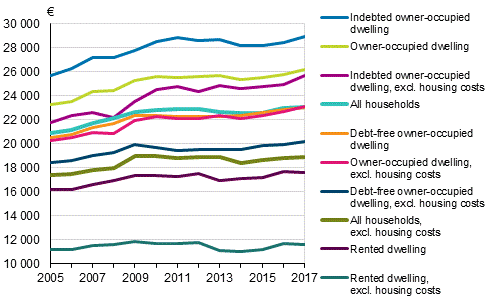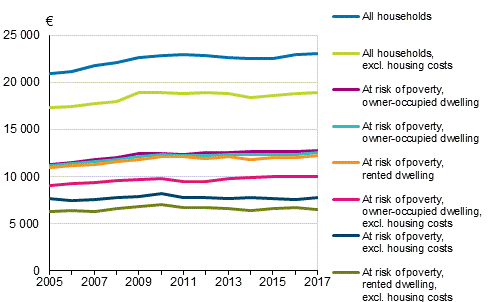Published: 13 March 2019
Income differential between households living in owner-occupied and rented dwellings remained nearly unchanged in 2017
After 2013 to 2014, the income level still improved slightly in 2017 for households living in owner-occupied dwellings. The growth in the income level halted for households living in rented dwellings. As in previous years, the income level after housing costs was nearly one-half of the income level of households living in owner-occupied dwellings. These data derive from Statistics Finland’s income distribution statistics .
Households’ median income according to form of tenure of the dwelling in 2005 to 2017, at 2017 prices

Income concepts: Equivalent disposable monetary income per household and equivalent disposable monetary income after housing costs per household, median income. Equivalent income is the household’s disposable income divided by the number of consumption units in households.
The real income level of households living in owner-occupied dwellings and rental dwellings was about three per cent higher in 2017 than in 2014. The real income level after housings costs was over four per cent higher for households living in owner-occupied dwellings and over five per cent higher for households living in rented dwellings than in 2014. The growth in the income level of households living in rented dwellings stalled weakly in 2017. Their favourable income development was caused by preceding years. The income after housing costs of those living in owner-occupied dwellings rose in 2017, both for the households with a housing loan and debt-free households.
In 2017, the median for equivalent disposable monetary income for all households was EUR 23,000 and after housing costs EUR 18,900. The income level of households living in rented dwellings was lower and housing costs took more of their income than average for households. Their median income in 2017 was around EUR 17,600 and after housing costs about EUR 11,600. From 2013 onwards, the income level after housing costs remained almost without exception the same for households living in rented dwellings, or about 60 to 61 per cent of households’ median income (62% in 2016), and around 50 per cent of the median income for households living in owner-occupied dwellings (52% in 2016). The income level of households living in rented dwellings was earlier higher in relative terms. For example, in 2005 to 2008, it was around 64 to 65 per cent of households’ median income, and 55 per cent of the median income for households living in owner-occupied dwellings.
The income level of persons at risk of poverty living in owner-occupied dwellings was only slightly higher (5%) than that of households living in rental dwellings (at risk of poverty, see concepts and definitions of the income distribution statistics ). After paying housing costs, the median income of households at risk of poverty living in owner occupied dwellings was in 2017 around one-half (53.1%) and that of households living in rental dwellings around one-third (34.5%) of all households’ median income. From 2014, the income of low-income households, households living in owner-occupied and rented dwellings grew by one to two per cent. The income development was weaker than in the entire household population.
Median income of households at risk of poverty by form of tenure of the dwelling in 2005 to 2017, at 2017 prices

Income concepts: Equivalent disposable monetary income per household and equivalent disposable monetary income after housing costs per household, median income. Equivalent income is the household’s disposable income divided by the number of consumption units in households.
The share of households burdened by housing costs among all households was the same as in the year before. In 2017, there were 180,400 such households, which is 6.6 per cent of all households. In total, 221,300 persons belonged to these households, or 4.1 per cent of the entire population. The share of the housing costs of disposable income, excluding housing allowances, of a household burdened by housing costs, is over 40 per cent. Housing allowances are not included in housing costs or disposable monetary income (the income share of housing costs, see concepts and definitions of the income distribution statistics ). At most, over seven per cent of households were burdened by housing costs in 2013 to 2014.
Source: Income distribution statistics 2017, Statistics Finland
Inquiries: Marie Reijo 029 551 2547
Director in charge: Jari Tarkoma
Publication in pdf-format (405.0 kB)
- Tables
-
Tables in databases
Pick the data you need into tables, view the data as graphs, or download the data for your use.
- Quality descriptions
-
- Quality report: Income Distribution Statistics (13.3.2019)
Updated 13.03.2019
Official Statistics of Finland (OSF):
Income distribution statistics [e-publication].
ISSN=1799-1331. Income differentials between population subgroups 2017. Helsinki: Statistics Finland [referred: 25.12.2025].
Access method: http://stat.fi/til/tjt/2017/03/tjt_2017_03_2019-03-13_tie_001_en.html

